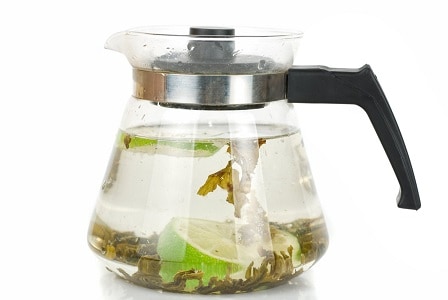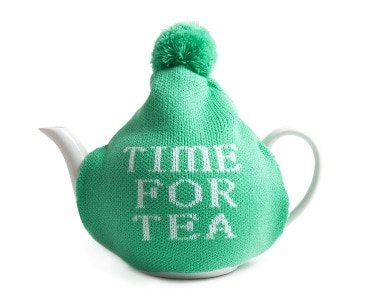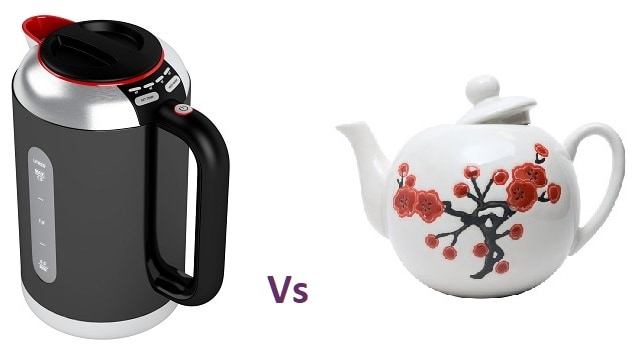Every type of equipment used in the kitchen serves a different and specific purpose. Using it for something it’s not meant to do will only damage it. Two such types of equipment are teapot and tea kettle. Both are required to make tea and, even though similar, are designed to do different things. We will differentiate between them and understand their uses better in this article.
Table of Contents
Difference Between Teapot and Kettle
What is a Kettle Used For?
A kettle is used to boil water or heat its temperature to the right level, primarily to make tea or pour over coffee. You can also use boiling water for oatmeal, instant noodles, and other drinks and dishes that need hot water. It is made with high heat resistant substances such as copper, aluminum, stainless steel, or stone pottery, which helps it hold out against the high temperature of boiling water and direct heat. You should be extremely careful while using a kettle as its only purpose is to heat water and not to actually brew tea in it. If you add any other ingredient to it, it will be difficult to clean and you will damage its interior by staining it.
Good kettles also come with a well-designed spout to pour and a robust handle to hold them. Gooseneck tea kettles are particularly good for controlling the pour so that the tea leaves or coffee grounds in a pour over filter are properly infused at the right speed for the best flavor.
What is a Teapot Used For?
A teapot is primarily used for steeping your tea. While boiling the water is done by the kettle, a teapot finishes the rest of the process of brewing the tea. Compared to a tea kettle, a teapot is not designed to withstand direct heat, and therefore hot water is poured into it along with the tea leaves so that they can infuse the water for a while to make tea. Teapots are mostly made of materials such as glass, porcelain, or ceramic. These materials are not good conductors of heat and may crack when they come in direct contact with a heat source, and that’s why we cannot use them to boil water while making tea.
Structurally, teapots come with an opening on top with a removable lid, which allows you to pour the boiling water in them comfortably without worrying about burning yourself or spilling the hot water. Many also have filters built into them so that the loose tea leaves don’t flow into your teacup, and some teapots have tea-infusers attached so that the leaves are neatly contained.
Teapots can be extraordinarily appealing to the eyes as well. Some glass, ceramic, and porcelain teapots are hand-crafted and hand-painted, making them a nice addition to your kitchen counter. In addition to that, there are old, antique teapots that are collectibles as well.
Can You Heat Up a Glass or Ceramic Teapot on a Stove?
Most glass or ceramic teapots cannot be heated up on a stove as they are delicate, and being exposed to direct heat will either break them or put cracks in them.

However, there is an exception in the case of a glass teapot. A specific type of glass called borosilicate can sometimes be used to heat water directly on the stovetop. It has a higher resistance to heat and fluctuating temperatures and is much more durable than regular glass. However, if borosilicate glass pots are not designed and made specifically for use on the stovetop, then I do not recommend using them in this way.
Even ceramic pots have an exception for using them on a stovetop directly. Some ceramic pots can be used on a stovetop, but you have to be careful and read the instructions to make sure that the manufacturer explicitly states that it can be used on a stove. One such safe glass-ceramic teapot is called Vintage Corningware, which is safe to use on a stovetop. The advantages of using ceramic pots are that they don’t spoil the taste of your tea, keep its flavor intact, and keep the tea hot for a more extended period. Ceramic pots are also fragile like glass pots and need to be handled properly to avoid breaking them.
Glass and ceramic teapots can be beneficial over other teapots as they are safe for brewing tea since they do not release any chemicals into the tea the way plastic does, and they don’t affect the taste and color of your tea the way some metal ones do. Also, glass and ceramic teapots are visually appealing and attract everyone’s attention if you’re using them at a tea party.
Since glass and ceramic are poor conductors of heat, the brewing tea won’t get cold too fast even if you don’t use a tea warmer. Glass teapots are microwave safe and easy to clean, which gives them an edge over the other teapots. However, they also have certain limitations like, if not handled with care, the glass or ceramic can crack. Certain glazed ceramic teapots contain lead and/or cadmium, which are hazardous to your health. It’s best to check for teapots that specifically say that they’re free from these substances. Even better, pick a ceramic that’s not glazed.
Types of Tea Kettles
Having discussed teapots in detail, it is now time to learn about the different kinds of tea kettles. There are three types of tea kettles available for you to choose from. They are stovetop kettles, electric kettles, and electric kettles with infusers. Each type has its place in heating water and making hot beverages.
A stovetop kettle is a commonly available kettle that uses a gas or electric stove to heat water. It does not have any advanced features like that of an electric kettle. Stovetop kettles are usually made of glass, copper, stainless steel, ceramic, or cast iron. Take a look at some of the best tea kettles for a gas stove. The metal ones are good conductors of heat and help in boiling water efficiently, while glass and ceramic take a longer time to heat up but once the water has reached the desired temperature, will not lose heat as fast. Sometimes the boiling on a stove gets excessive since there are no temperature checks with these kettles unless you manually insert a food thermometer to check the temperature.
An electric kettle uses electricity to heat the water. This kettle is more advanced in features as it boils water at a faster rate and many allow you to see and adjust the temperature according to your needs. A very useful feature of this kettle is its thermostat, which automatically shuts off the kettle when the water reaches your desired temperature. This prevents the water from over-boiling or the kettle from boiling dry. They are also energy efficient as they don’t need outside sources to generate heat, some of which escapes and isn’t utilized. They have a heating element built-in. Overall, electric kettles are the most convenient type of kettles to use to heat your water. Here are our recommended electric kettles with temperature control.
The third and the best type of kettle is the electric kettle with an in-built infuser. No matter how convenient having both a teapot and kettle is, it is still time-consuming to first heat water in the kettle and then steep the tea leaves or tea bags in the teapot. Instead, the fastest and most convenient option is to buy an electric kettle with an infuser that will function both as a teapot and a tea kettle. Infusers in these kettles come in different shapes, such as conical, cylindrical, and spherical. These kettles also come with a timer for steeping the tea and have temperature controls that help achieve the desired temperature for your water, depending on the type of tea you’re brewing. One downside to these kettles is that they’re quite expensive.
Do I Need a Tea Kettle?
Now that you’re aware of the specific functions of the tea kettle, choosing whether you need it will boil down to your personal needs and preferences. While having a tea kettle will make your work much easier, it is not a necessary piece of equipment needed to boil water. You can always boil water in a saucepan and use it for brewing your tea. However, a tea kettle provides its comforts. Whether it’s an electric kettle or a stovetop kettle, each has its advantages.
At the end of the day, having a kettle is not necessary to make tea. Tea can be made with a regular saucepan and mug, and therefore it is your choice to decide whether you need it or not.
Do I Need a Teapot to Make Tea?
You don’t necessarily need a teapot to make tea. While having a teapot can make your work of brewing tea for more than one person easier and it looks aesthetically pleasing at your parties, tea can be brewed in a mug as well. As I previously mentioned, some people might want only a teapot, some only a kettle, some both, and some neither. Tea can be made in other utensils and having a teapot is not necessary for making it.
Is it Cheaper to Boil a Kettle or a Pan?
An electric kettle will probably be slightly cheaper than a stovetop kettle or a pan when the cost is considered. Electric kettles are made at least 80% energy efficient, whereas a stove is about 70% energy efficient and you need to turn it off yourself as soon as the water has reached a boil. However, per unit of electricity is costlier than per unit of gas. This is why there will not be too much of a difference in the cost, and an electric kettle might be slightly cheaper.
How to Keep Tea Hot for a Long Time
Tea tastes the best when it’s hot. When you’re too busy and make tea well before you drink it, you would still want it to be hot. However, if you leave it in the teapot, it is bound to get cold. To avoid that and to keep your tea hot, you can use a tea warmer. It helps in maintaining the temperature of the tea in the teapot with the use of a heating implement called a tea candle. It does so without burning the teapot or making the tea bitter by overheating it.

Another thing that can be used to keep the tea hot is a tea cozy. It is an electric or non-electric cover that acts as an insulator and keeps the tea warm. It is better to place the teapot on a trivet or spare towel instead of a cold surface to help it retain more heat.
Conclusion
So to sum up the differences, a kettle is what you need if you want to heat up or boil water for tea or for pour-over coffee, oatmeal, instant noodles, etc. You pour the water from that into whatever utensil holds the tea leaves, coffee grounds, or dried food. A teapot is exclusively meant for steeping tea in the form of loose leaves or tea bags and you pour the brewed tea from it into your cup.


